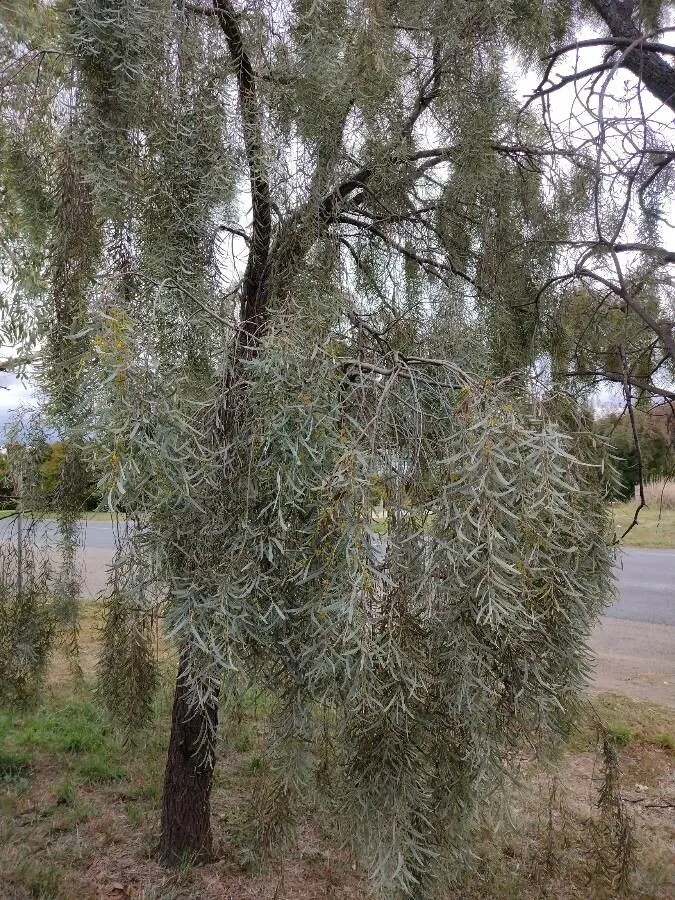
Author: A.Cunn. ex G.Don
Bibliography: Gen. Hist. 2: 404 (1832)
Year: 1832
Status: accepted
Rank: species
Genus: Acacia
Vegetable: Unknown
Observations: E. & SE. Australia
Acacia pendula, commonly known as Myall acacia, is a remarkable species of wattle that belongs to the Fabaceae family. This elegant plant is indigenous to the eastern and southeastern regions of Australia, where it contributes significantly to the unique biodiversity of these landscapes.
The Myall acacia is noteworthy for its distinctive weeping form, with branches that arch gracefully, giving the tree an ornamental appearance. The leaves, or phyllodes, of Acacia pendula are slender and grey-green, adding to the plant’s delicate, ethereal beauty, while its small, yellow, spherical flowers provide a striking contrast when in bloom. The flowering typically occurs in clusters, presenting a soft, golden spectacle that can significantly enhance the aesthetic value of any environment it inhabits.
First described in 1832 by the eminent botanist Alan Cunningham and later by George Don, the Myall acacia has since been recognized not only for its visual appeal but also for its adaptability and resilience in various growing conditions. It can thrive in both arid and wetter areas, making it a versatile choice for restoration projects and ornamental gardening across Australia.
The ecological importance of Acacia pendula cannot be overstated. It plays a crucial role in its native habitats, providing shelter and food for a variety of wildlife. Its ability to fix nitrogen in the soil improves the quality of the surrounding environment, promoting the growth of other plant species and enhancing soil fertility.
For those considering cultivating this graceful tree, it is important to note that it prefers well-drained soils and full sunlight. While it is relatively low maintenance, regular pruning can help maintain its shape and encourage healthy growth.
In summary, Acacia pendula, or Myall acacia, is an exceptional plant with a perfect blend of beauty and ecological value. Its delicate structure, vibrant flowering, and hardy nature make it a valuable addition to both natural landscapes and cultivated gardens in Australia and beyond.
Afr: boree, treurwattel
Eng: myall acacia, weeping myall, balaar, boree, myall, nilyah, silver-leaf boree, true myall
En: Myall acacia, Weeping myall, Balaar, Boree, Myall, Nilyah, Silver-leaf Boree, True Myall
Af: Boree, Treurwattel
© copyright of the Board of Trustees of the Royal Botanic Gardens, Kew.
© copyright of the Board of Trustees of the Royal Botanic Gardens, Kew.
© copyright of the Board of Trustees of the Royal Botanic Gardens, Kew.
Taken Jun 2, 2022 by Jhon Christian Moreno Gómez (cc-by-sa)
Taken Oct 31, 2020 by Rina Jeger (cc-by-sa)
Taken Dec 7, 2021 by Chris Crispe (cc-by-sa)
Taken Apr 6, 2022 by Boris Therock (cc-by-sa)
Taken Apr 6, 2022 by Boris Therock (cc-by-sa)
Taken Nov 7, 2020 by esra (cc-by-sa)
Taken Oct 19, 2020 by Małgorzata Dębowska (cc-by-sa)
Taken Jun 2, 2022 by Jhon Christian Moreno Gómez (cc-by-sa)
Taken Dec 7, 2021 by Chris Crispe (cc-by-sa)
Taken Apr 6, 2022 by Boris Therock (cc-by-sa)
Taken Jun 2, 2022 by Jhon Christian Moreno Gómez (cc-by-sa)
Taken Oct 31, 2020 by Rina Jeger (cc-by-sa)
Taken Apr 6, 2022 by Boris Therock (cc-by-sa)
Taken Oct 31, 2020 by Rina Jeger (cc-by-sa)
Taken Dec 7, 2021 by Chris Crispe (cc-by-sa)
Family: Myrtaceae Author: (F.Muell.) K.D.Hill & L.A.S.Johnson Bibliography: Telopea 6: 402 (1995) Year: 1995 Status:…
Family: Rubiaceae Author: Pierre ex A.Froehner Bibliography: Notizbl. Bot. Gart. Berlin-Dahlem 1: 237 (1897) Year:…
Family: Sapindaceae Author: Koidz. Bibliography: J. Coll. Sci. Imp. Univ. Tokyo 32(1): 38 (1911) Year:…
Family: Asteraceae Author: A.Gray Bibliography: Pacif. Railr. Rep.: 107 (1857) Year: 1857 Status: accepted Rank:…
Family: Fabaceae Author: Medik. Bibliography: Vorles. Churpfälz. Phys.-Ökon. Ges. 2: 398 (1787) Year: 1787 Status:…
Family: Aspleniaceae Author: (Cav.) Alston Bibliography: Bull. Misc. Inform. Kew 1932: 309 (1932) Year: 1932…